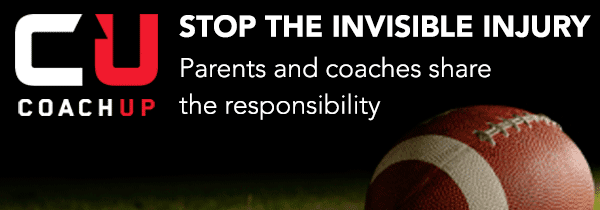The risk of suffering from brain trauma exists not only at the professional level, but also for young kids across most sports. Early education and a shift in the “tough it out” mentality is needed in order to reduce the frequency of concussions in young athletes, as well as, reduce the number of concussions that go undiagnosed. Parents and coaches have to raise the bar and set the standard that the athlete’s health is first priority.
Suffering from a concussion can occur in any sport, and at all levels of play, from little league to the major leagues. The US Center for Disease Control estimates 1.6 million to 3.8 million concussions occur in sports and recreational activities each year. The recent NFL players lawsuit and Frontline’s “League of Denial” have helped raise mainstream awareness of concussion safety. We now have clear proof, as well as, a court precedent acknowledging that concussions are a threatening injury that can compromise an athlete’s future health and quality of life.
We’ve learned that the result of multiple concussions and repetitive brain trauma can be severe and could manifest into the brain disease Chronic Traumatic Encephalopathy (CTE). CTE is a degenerative disease that causes changes in the brain which can begin months, years, even decades after the last brain trauma. According to the Boston University Center for the Study of Traumatic Encephalopathy (BU CSTE), the leading research program studying CTE, this disease can cause memory loss, confusion, impaired judgment, impulse control problems, aggression, depression, and, even dementia.
A concussion is type of traumatic brain injury (TBI) that can occur in both contact and non-contact sports. A concussion is a bump, jolt or blow to either the head or body that causes the brain to move quickly back and forth, and or twist within the skull.
Chris Nowinski
Source: AthleticBusiness.com
Chris Nowinski is the director of the Sports Legacy Institute (SLI), a non-profit organization dedicated to solving the sports concussion crisis through education, policy, and research. He is also co-director of the BU CSTE. Nowinski points out that the danger for young athletes who have suffered a concussion is their inability to recognize, and articulate, the symptoms they experience to an adult. “(Concussions are) thought to be more damaging in the younger brain; although every concussion is different. The additional risk with children is that they may not recognize the injury themselves and may not report the symptoms. We have to be especially careful with children before high school, before they are physically and cognitively mature.”
According to the Positive Coaching Alliance, approximately 65-80% of initial concussions go unrecognized. As to the correlation between the number of concussions sustained and CTE, Nowinski notes, “There is no number of concussions that correlates with any jump (in chances of experiencing CTE) which is why we have to follow the same process of making sure the athlete is seeing an experienced doctor after any trauma.”
Inundated with bits of information from all angles and outlets regarding the dangers of concussions, a parent can be left wondering; are youth sports safe for children? The answer is, yes. As with any sports or recreational activity, there is a risk for injury. The degree of safety depends on a coach’s training philosophy and their experience with concussion prevention and awareness.
The Reebok Checklight
Isaiah Kacyvenski is a former NFL player who has been diagnosed with 7 concussions. He is also a Board member at the Sports Legacy Institute (SLI), non-profit organization dedicated to solving the sports concussion crisis through education, and the lead advisor to MC10. Kacyvenski worked with MC10 to create Checklight with Reebok, a sports and activity impact monitor for the head to help improve recognition of trauma. On the state of youth sports safety, Kacyvenski acknowledges there is room for improvement,“When you look at the kaleidoscope of sports, football to ice hockey, soccer to basketball, there’s a level of physicality and play that can place an athlete in harms way. I think that youth sports can and should be played safely. Right now they aren’t always though.” In order to reduce the chances of a head injury it is critical to play the game with an emphasis on legal moves and reinforce ongoing concussion awareness and prevention.
Isaiah Kacyvenski
Source: Michael Conroy, AP[/caption]
Coaches and parents have primary responsibility to push education around safety and concussion prevention. For coaches, concussion education must start on the first day of practice and continue through each season. For parents, it starts right when a child expresses interest in sports, and recreational activities, long before the first day of practice ever comes around. The days of passive parenting are gone; parents must take an active role in starting and continuing sports safety education with their child. With ongoing education comes not only awareness, but a shift in behavior. For all parties involved, athletes, coaches and parents, recalling concussion symptoms must be second nature so subtle symptoms get immediate medical attention.
Parents and coaches should be aware of subtle concussion symptoms. These occur when an athlete:
- Appears dazed or stunned
- Is confused about an assignment or position
- Forgets an instruction
- Is unsure of game, score, or opponent
- Moves clumsily
- Answers questions slowly
- Loses consciousness (even briefly)
- Shows mood, behavior, or personality changes
- Can’t recall events prior to a hit or fall
- Can’t recall events after a hit or fall
More severe symptoms may be present when an athlete:
- Has one pupil larger than the other
- Is drowsy or cannot be awakened
- Has headache that gets worse
- Has weakness, numbness, or decreased coordination
- Exhibits repeated vomiting or nausea
- Slurs his speech
- Has convulsions or seizures
- Cannot recognize people or places
- Becomes increasingly confused, restless, or agitated
- Presents unusual behavior
- Loses consciousness (even a brief loss of consciousness should be taken seriously)
Max Lane
Source: thehallatpatriotplace.com
Concussions have been deemed the “invisible injury.” As a parent or coach it can be a challenging decision to “tough it out” or pull your athlete out of the game. CoachUp coach Max Lane says, “Education for youth coaches and parents is key in figuring out where that fine line is in the grey area of head injuries.” Lane was an offensive lineman, protecting the likes of Quarterbacks Drew Bledsoe and Tom Brady, during his days with the New England Patriots.
“When you hurt your arm, your leg…the severity of an injury is fairly obvious. Whereas with the head, we don’t see it, and we just don’t know. Coaches and parents have to be on the lookout for the signs; dizziness, drowsiness, pupil dilation…” Those signs are what Nowinski and Kacyvenski are helping coaches pick up on with their work at SLI. Even with greater awareness parents and coaches must be willing to err on the side caution to protect young athletes.
It’s easy to ignore the research and recent warning until brain trauma hits closers to home. Nick Stamas, a CoachUp lacrosse coach, was a standout high school and college athlete who over his athletic career endured a number of concussions playing sports. His most severe concussion experience occurred while skiing with his father over winter break in college. Stamas attempted a trick jump and sustained a severe TBI, he was rushed to the hospital where he laid unconscious for a week with brain swelling and bleeding. The repercussions of this incident have had long term effects; he is unable to experience hunger or fullness and he no longer can experience the sensations of taste nor smell. Immediately after the event, he temporarily lost temperature sensation to the right side of his body, which only returned two years later.
Stamas knows how hard it can be for a coach or trainer to miss a symptom and as an athlete, he knows how it easy it is for an athlete to ignore or push through injury. His advice to coaches, parents and athletes, “seek and listen to the medical professionals. I’m a competitive person and, as an athlete, I had this mentality of I think ‘I can do it all’ and “I have the answers to everything.’ When it comes to how severe and complicated this injury is, you can’t be that way. You have to take a step back and listen to the professionals.”
Stamas urges parents and coaches to make sure their children take time off to properly heal after any trauma and to listen to the advice of a trained medical professional. According to Liberty Mutual Insurance’s Responsible Sports Survey, 20-30% of athletes say they are symptom free before their brains are fully healed by clinical standards. Stamas and his doctors suspect his history of concussions lead to the severity of his last, and most severe, injury. Athletes that have incurred one concussion are at an increased risk to sustain another, and to experience “second impact syndrome.” The CDC defines “second impact syndrome” as subsequent concussions before the brain fully recovers from the first trauma. This is where the most severe, long term damage can occur in an athlete.
Based on a foundation of competition and physical perseverance, it’s hard to withstand the “win at all costs” pressure that has come to exist in athletics. Knowing when to pull an injured athlete is the first step in concussion safety and protecting an athlete’s future. Kacyvenski notes this is perhaps most overlooked aspect of concussion awareness and maybe the most difficult element of sports culture to change. A cultural and environmental shift must come about in order to keep young athletes safe during practice and competition. Lane seconds that sentiment, “Everybody wants to win. Coaches have to let the players know that at the beginning of the season that the coach is fostering an atmosphere of safety first, even when that means safety over winning. The coach has to communicate to the players that it’s okay for them to speak up if they’ve been hit in the head.” Coaches, trainers and parents must come together to create an environment where athletes feel empowered to speak up when something is wrong. [caption i Cam Neely, Source: AP Photo, Steven Senne
Cam Neely, Source: AP Photo, Steven Senne
That atmosphere starts with the coaches and trainers, and funnels down to even to the parents, athletes and spectators. Those changes must begin at the youth level where proper technique and good, clean, legal play are consistently enforced and, above all, applauded. With a professional NHL career under his belt and now the responsibility of overseeing one of the most successful NHL franchises of all time, President of the Boston Bruins, Cam Neely, echoes the importance of athletes understanding how to play their sports safely. For impact sports, “the athlete needs to understand if someone is in a vulnerable position, he can still take them out of the play and do that in a manner that isn’t going to jeopardize any player’s health,” Neely says. The people responsible for equipping the athletes with the knowledge and skills to do this are the coaching staff. Even coaches for non-contact sports must keep an eye for proper form and technique. Pole vaulters, high jumpers, horseback riders, skaters, skateboarders, cyclists and even swimmers are all at risks for a concussion when in action.
Jackie Bledsoe Jr. and family, CoachUp sportsdad and blogger
A move to safer play in all sports, especially at the youth level, is due. While parents may not be teaching their athletes the finer details of strategy and technique, parents can reinforce a safe sports environment by not promoting or encouraging moves that might comprise an athlete’s safety. Parents can also remind athletes of concussion symptoms to be on the lookout for, throughout the season in order to keep the injury front of mind.
Coaches and trainers can continue to stay educated on concussion prevention and treatment in order to create a practice and game time environment that is focused on both athletic achievement, as well as, safety. It’s never too late to start concussion education with young athletes, and we should never stop emphasizing the importance of concussion awareness.
CoachUp’s Top 10 Concussion Awareness Tips for Parents
1. Learn the symptoms of concussions and traumatic brain injuries. Review the CDC’s fact sheet for parents http://www.cdc.gov/concussion/pdf/Parents_Fact_Sheet-a.pdf and take the CDC’s free online course http://www.cdc.gov/concussion/HeadsUp/Training/index.html.
2. Review the CDC’s fact sheet for athletes with your child http://www.cdc.gov/concussion/pdf/Athletes_Fact_Sheet-a.pdf then quiz your child on the symptoms, on an ongoing basis.
3. Introduce yourself to your child’s coach in a friendly and open manner so that the coach will always feel comfortable coming to you with any concerns regarding your child. Continue to maintain regular contact with the coach over the season by greeting them after practice and games.
4. Ask your child’s coach how he or she will be conducting concussion education over the course of your child’s season. Be familiar with the CDC’s guide for coaches http://www.cdc.gov/concussion/pdf/Coach_Guide-a.pdf
5. Identify whom the trainer or medical professional is at your child’s sports organization or school, and find out if they will be attending games. You should alway know who is in charge of medical care or who to ask should your child ever get hurt.
6. Make sure your child’s medical information is always on file and up to date with their sports organization and school.
7. Consider giving a laminated list of important contact and medical information to your child to keep in their gym bag. It should include your name, number, their primary care physician contact information and health insurance information, as well as any pre-existing conditions, including a prior history of concussions.
8. Encourage your child to talk to his coach on a regular basis, so he or she develops a comfortable and open relationship with their coach.
9. During, and after competitions, make an extra effort to celebrate when your child makes a play that is completed with good form and technique. If you see your child making plays that are overly violent, talk to your child about it immediately after the game. If your child says that was how he was taught to play, consider following up with your child’s coach to review how you can help reinforce safe play with your child, which, will help reinforce coach that you want your child being coached safely.
10. Revist concussion information materials and refresh your memory with the CDC’s fact sheet for coaches.
Go the extra mile:
Consider sharing the Sports Legacy Institute’s Concussion Checklist and information on the SLI Advanced Concussion training information with your child’s coach, school or sports organization.
http://www.concussionchecklist.org/
http://www.sportslegacy.org/education/advanced-concussion-training/
http://www.sportslegacy.org/events/
CoachUp is a service that connects athletes with private sports coaches. Visit CoachUp to find the perfect coach for you today: http://www.coachup.com
How useful was this post?
Click on a star to rate it!
Average rating 0 / 5. Vote count: 0
No votes so far! Be the first to rate this post.









